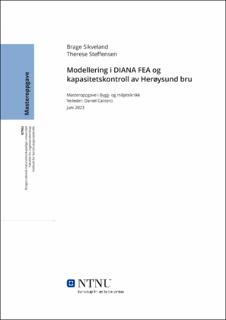| dc.description.abstract | Oppgaven omhandler Herøysund bru, som er en etteroppspent betongbru i Nordland fylke.
Brua er en del av et pågående forskningsprosjekt, og i den forbindelse er overbygningens
kapasitet i intakt tilstand vurdert, i henhold til Eurokode 2. Her er tre utvalgte snitt
kontrollert. Det fremkom at den er tilstrekkelig dimensjonert med hensyn på bøyemoment.
Modellering utføres i dataprogrammet DIANA FEA, som benytter elementmetoden under
beregning. Innledningsvis er det utført tester på enkle modeller for å finne mest optimale
metoder å benytte videre. Her ble det blant annet undersøkt hvordan symmetri kan benyttes
for å forenkle modellen, og dermed oppnå redusert beregningstid. Basert på dette
er det dannet en halvert modell av brua, hvor laster innføres.
Grunnlag for modellering og beregninger er arbeidstegninger fra opprinnelig prosjektering.
Brua påkjennes av egenlast, spennkraft, trafikklast og vindlast. Lastene er funnet i henhold
til aktuelle Eurokoder, samt håndbøker fra Statens vegvesen. Videre er de beregnet med
lineær analyse i ulike lastkombinasjoner. Ettersom brua og armeringens geometri er noe
kompleks, er det dannet et Python-script for å modellere dette mer effektivt. Kapasitetskontroll
av utvalgte snitt er utført gjennom håndberegninger i programmet Mathcad.
Resultater er sammenlignet med beregninger tidligere utført for brua. Slik er det undersøkt
hvilke forskjeller som oppstår ved bruk av ulike beregningsregler og metoder. Det fremkom
at brua trolig har bedre kapasitet enn funnet tidligere.
Avslutningsvis utføres det en probabilitetsstudie angående bruas sviktsannsynlighet med
hensyn på ulike materialdata for spennarmering og betong. Det undersøkes hvilken innvirkning
en endring av friksjonskoeffisient og betongens trykkfasthet vil ha på bruas kapasitet
og bøyemoment. Probabilitetsstudien viste at bøyemoment ble påvirket mest av friksjonskoeffisienten,
og at betongkvaliteten hadde mindre innflytelse. For kapasiteten hadde kun
betongkvaliteten en innvirkning. | |
| dc.description.abstract | The objective of this assignment concerns the Herøysund bridge, which is a post-tensioned
concrete bridge in Nordland County. The bridge is part of an ongoing research project, and
in that regard the capacity of the superstructure in intact condition is assessed, according
to Eurocode 2. Three selected sections were controlled, demonstrating that the structure
is adequately designed in terms of bending moment.
Modelling is carried out in the computer program DIANA FEA, which uses the finite element
method in calculations. Initially, tests were carried out on simple models to find the most
optimal methods to use in further modelling. Among other things, it was investigated how
symmetry can be applied to simplify the model, and thereby achieve reduced calculation
time. Based on this, a halved model of the bridge is created, where loads are introduced.
The basis for modelling and calculations are drawings from the original design. The bridge
is loaded by self-weight, prestressing force, traffic load and wind load. The loads have been
found in accordance with relevant Eurocodes, as well as manuals from Statens vegvesen.
Furthermore, they are calculated through linear analysis in various load combinations. As
the geometry of the bridge and the reinforcement is somewhat complex, a Python-script
has been created to model this more efficiently. Capacity control of selected sections is
carried out through hand calculations in the program Mathcad.
Results are compared with calculations previously carried out for the bridge. Differences
that occur when using different calculation methods and rules are this way examined. It
emerged that the bridge likely has a better capacity than previously found.
Finally, a study is carried out regarding the probability of failure for the bridge with consideration
of different material data for post-tensioning reinforcement and concrete. It is
investigated which influence a variation of the friction coefficient and the concretes compressive
strength will have on the bending moment, as well as the moment capacity. The
study showed that bending moment was mostly affected by the friction coefficient, and that
the concrete quality had less of an influence. For the capacity, only the concrete quality
had an impact. | |
